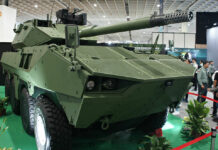The launch of the Russian-made Sina-1 (also called Mesbah- “Lantern”) satellite into orbit aboard a Russian Kosmos-3M booster rocket, in October 2005, marked the start of Iran’s accelerated space program, and Tehran officials said that a second satellite – this one an Iranian-built – could be launched early 2006 or early 2007, a warning which already raised Israeli concerns.
In fact, on February 26, 2007 there were reports circulating that Iran has launched its second communications satellite, called Safir-313. Although no details were released, Iran is known to have developed a satellite launch vehicle of the Shahab family quite similar with the DPRK’s Taepodong 2 named IRIS. The day before, Iranian state-run television announced that a rocket, carrying unspecified cargo created by the ministries of science and defense, was successfully launched. Later reports stated that the rocket was not intended for the orbital flight, being a “sounding rocket”. After reaching the altitude of about 150 kilometers, it was designed to descend back to Earth using a parachute. The US Military expressed doubts about this launch since it was claimed not to have been detected by NORAD.
The Iranians had officially declared their space ambitions back in 2003 when defense minister Admiral Ali Shamkhani made a sensational statement warning that Tehran would launch its first satellite with a home-produced booster-rocket within eighteen months. The words had shocked the Western experts, since the Iranian booster for the satellite could also carry a nuclear charge of intercontinental range. According to Yiftah Shapir, a former air force officer and currently researcher at the JCSS, not many details are known about the Sinah-1, but it carries two cameras and communication equipment and is reported to weigh 160 kilograms. Although Iranian officials have calmed that the satellites are designed to locate and monitor natural resources and perform other, similar missions, Israeli and American intelligence sources have pointed to the future military dimension of the Iranian space program
Tal Inbar, vice president of the Israeli Space Society warns that that the development of the Iranian space program could allow Tehran to enhance the development of its long-range ballistic missile program while eluding the Missile Technology Control. It is well known that technologies accompanying the development of space satellites such as micro electronics can also be dual-used as cover for the development of small size nuclear weapons which will fit the advanced version of the evolving Iranian Shahab missile project.
However, a closer examination of the projects in which Iran has been engaged in developing its space program shows considerable difficulties in attaining its target dates. When efforts to design an indigenous booster went off to a bad start, the the Iranian research institute in charge of the project, turned to the Russian Omsk-based Polet design bureau which took over the work on the spacecraft. As result, the Sinah-1 launch came extremely late considering Iran’s remarkable efforts in other space related projects, such as its ambitious ballistic missile program. The case of its other satellite, named Zohreh is even more revealing; more than 30 years of continuous efforts have yet to materialize. In fact, Iran has again turned to Russia to order the construction of the Zohreh satellite, which is now being developed by the Reshetev Research and Production center at Zheleznogorsk.
Nevertheless, Israeli security experts regard Iranian’s recent success as a milestone event, clearly signaling its determination to expedite its efforts in space. Committed to the development of the space booster launch vehicle ‘IRIS’ a few years ago, Iran had achieved considerable know-how through its co-operation with the North Korean No-Dong missile technology. Western space experts studying intelligence photos of an advanced Iranian version of the Shahab -3 ballistic missile estimated the vehicle capable to carry an additional second stage solid motor in its bulbous front. This they regarded could contain a future satellite payload, making the IRIS launch vehicle a space-related ballistic missile.
However, the Iranian space program has already suffered some painful setbacks in the past. On July 12, 2001 the Jerusalem Post reported, quoting the Saudi Arabian Ashark al-Awsat, that Iran’s chief engineer Ali Mahmoudi Mimand, called the “Father of Iran’s missiles” and Tehran’s space program had ” passed away under mysterious circumstances”, a demise, which had never been officially explained to the public.
Saudi Arabia has invested considerable resources in creating a remote-sensing infrastructure, including an advanced centre, located in Riyadh. In late 1994, a Saudi company known as EIRAD, owned by Prince Fahd Bin Salman, sought to acquire a major interest in Eyeglass (now OrbImage), in return for an agreement to build a ground station in Riyadh and exclusive rights to receive and distribute OrbView satellite images in the Middle East. (EIRAD acquired a 20% interest in the company.) The main customer is expected to be the Saudi Defence Ministry.36 As noted above, this involvement raised fears in Israel regarding the use of this system to gather military intelligence information that would be used by various Arab states and terrorist groups against Israel. In addition, the Saudi Centre for Remote Sensing (SDRS), located in Riyadh, was established in 1983, and is developing an advanced capability for data analysis. In 1999, SDRS signed an agreement with RADARSAT International (Canada) for exclusive ordering, scheduling, reception, and product generation of RADARSAT I (7 meter resolution) data for the Middle East.
















